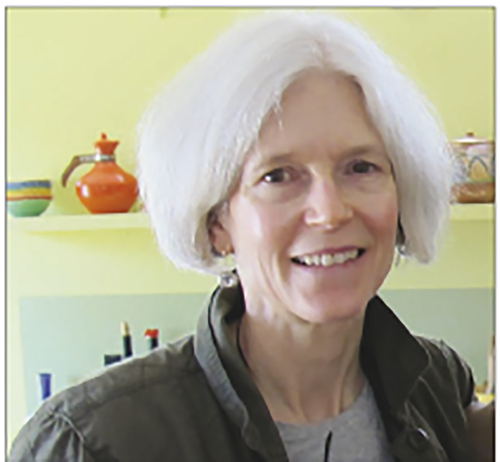“In this approach, art making is understood to be a form of inquiry, and art integration, a practice that goes beyond simple illustration of academic subject matter to one that develops deeper understanding of subjects and how they work together as a whole.”
—Julia Marshall (Citation2019a, p. xi)
I first met Julia in 1992 when I was a graduate student in her course Art for Children at San Francisco State University. I vividly remember her teaching. Shying away from strictly skills-based lessons, Julia encouraged big ideas and theme-based teachings by integrating contemporary art as a model for creative visual thinking and multidisciplinary learning.
Julia Marshall championed teaching that connected theory with practice through creative inquiry and arts-based approaches to learning (Marshall & Donahue, Citation2014). She embraced contemporary art for its humor and juxtaposition of concepts, which can provide layers of meaning, present irony, or create a scene with detail and depth, putting the learner right in the middle of it all. Promoting play and experimentation through her teaching, Julia continually encouraged and inspired divergent thinking, new ideas, and art integration—a skill set much needed for today’s classrooms.
Receiving two of the highest honors by National Art Education Association (NAEA), the Lowenfeld AwardFootnote1 and Higher Education Art Educator of the Year Award for the Pacific Region, exemplified her work in art integration nationally and internationally. Inspired by her Lowenfeld Lecture, Julia’s book, The Illustrated Guide to Integrated Learning (Citation2019b), richly depicts her own collages and illustrations where she playfully explains complex concepts of transdisciplinarity, constructivism, and creative inquiry through metaphor and infographics.
Anne Thulson, a frequent collaborator with Julia, shared that Julia was her “lifeline” when she taught art to elementary-aged children. Marshall’s work in art integration provided tools and strategies for Thulson to enact a contemporary art–driven and conceptually based curriculum. Thulson articulated, “[Marshall], through her collaborative research with classroom teachers, discovers and offers accessible models of complex, informed, 21st-century art curriculum that profoundly connect making with thinking” (personal communication, June 28, 2016). Julia’s focus on authentic connections in disciplines, rather than reductional formulas, made her teaching methods accessible. For Thulson, Julia’s work allowed her “to generate new ideas that birthed new projects and new tangents” (personal communication, June 28, 2016). Marshall does not simply suggest that teachers should integrate visual art across the curriculum; she shows us how.
Integrating the Visual Arts Across the Curriculum: An Elementary and Middle School Guide (Citation2019a), another key text by Marshall, provides rich examples from the classroom, along with contemporary art and illustrations. In the text, she argues for a need to engage with creative inquiry through art-based curriculum integration. Cementing this argument, Bae (Citation2020) states, “Marshall’s book serves a valuable dual role—as a catalyst to stimulate learning, and as a lens through which to view knowledge and the world differently than before” (p. 371). Her latest contribution to the field was the book Teaching Contemporary Art With Young People: Themes in Art for K-12 Classrooms (Citation2021), cowritten with Connie Stewart and Anne Thulson. Providing a framework that looks at contemporary art and teaching through the lens of nine themes—self and others; science, nature, and the earth; the everyday; space and place; power; popular culture; work; time and change; and inheritance—the book broadens and updates the art “canon,” and includes examples to spur creative and critical thinking. The book’s companion website, https://www.teachingcontemporaryart.com, offers curriculum resources on its nine key themes, thus serving as an accessible way for teachers and students to explore the limitless world of new art. By bringing educators into a deeper conversation about art integration and contemporary art, the book offers strategies for what, why, and how to move from a skills-based curriculum to a more conceptually and inquiry-driven model of teaching and learning.
Thulson reminds us that Julia Marshall “reach[es] out to classroom teachers and spark[s] in them the possibility that teaching is research, and the divergent paths of inquiry are rich with enchantment” (personal communication, June 28, 2016). I am going to miss Julia’s generous mentorship, quirky sense of humor, and her delight in the eccentric and absurd. Leonard Hunter, Julia’s husband, described her as “upbeat, loving, with an exciting personality both as a teacher, and as an adventurous traveler and world cultures’ connoisseur” (personal communication, March 24, 2022). Marshall’s ability to ignite wonder and curiosity remains vital and vibrant, living on in her pivotal work about integrating contemporary visual art across the curriculum.
Acknowledgment
My thanks to Leonard Hunter for reading a draft of this commentary.
Additional information
Notes on contributors
Lisa Hochtritt
Lisa Hochtritt, Faculty and Director, Master of Arts in Teaching program, Maryland Institute College of Art in Baltimore. Email: [email protected]
Notes
1 The Lowenfeld Award honors an individual who, over the years, has made significant contributions to art education.
References
- Bae, J. (2020). Review of Integrating the Visual Arts Across the Curriculum: An Elementary and Mddle School Guide. Studies in Art Education, 61(4), 367–372. https://doi.org/10.1080/00393541.2020.1820841
- Marshall, J. (2019a). Integrating the visual arts across the curriculum: An elementary and middle school guide. Teachers College Press.
- Marshall, J. (2019b). The illustrated guide to integrated learning. Poetry Box.
- Marshall, J., & Donahue, D. M. (2014). Art-centered learning across the curriculum: Integrating Contemporary Art in the Secondary School Classroom. Teachers College Press.
- Marshall, J., Stewart, C., & Thulson, A. (2021). Teaching contemporary art with young people: Themes in art for K–12 classrooms. Teachers College Press.

